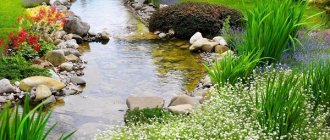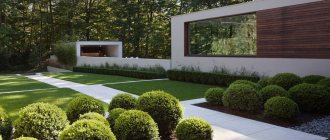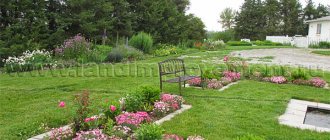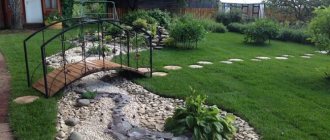The Mediterranean style in landscape design is becoming increasingly popular. The Mediterranean Sea is located in the subtropical zone, and a huge number of different varieties of flowers and abundantly flowering shrubs grow on its coast.
The Mediterranean garden in central Russia cannot boast of the lushness and diversity of subtropical vegetation. Therefore, in temperate climates, design style is achieved by using natural or artificially made stones, marble chips, different types of sea pebbles and growing adapted subtropical plants in flowerpots.
Mediterranean-style landscaping features large clay vases holding graceful flowers.
The Mediterranean style is notable for the use of various types of tiles for decoration. Terracotta tiles were used to design the garden path leading to the house.
A Mediterranean-style garden is decorated with all kinds of retaining walls, stairs and terraces. Mediterranean style combines elements of the art of Ancient Greece, Rome and modern times. One of the features of this style is toparia. Special pruning of plants to give them original shapes makes the garden design individual and memorable.
Important: in the Mediterranean style, the use of a lawn is practically eliminated. All plants are planted in hanging flowerpots, floor tubs, and ceramic pots.
The abundance of flowers is one of the distinctive features of the Mediterranean style.
The fountain for decorating the courtyard was selected in accordance with the requirements of the Mediterranean style.
Characteristic features of the style
A Mediterranean-style garden is similar to a Moorish garden: a small patio, a small plot and a blank fence wall. The color scheme is expressed in blue, white, terracotta and yellow. The Mediterranean Sea has mountainous shores, so this style is ideal for sites located in hilly areas.
Mediterranean style landscape design carries the main idea: unity with nature and creating a feeling of the vastness of the sky.
A large number of flowers are planted in the garden; small trees growing in the Mediterranean basin are brought outside in ceramic pots: oleanders, laurels, ficuses, thujas.
Mandatory attributes of a Mediterranean patio are an open gazebo, veranda, terraces, fountains and paths made of light-colored stone or ceramic tiles in a shade similar to clay.
The landscape design of the garden is not tied to the center of the site; in this style, such a concept as the center of the site is completely absent. Design elements are not connected by any semantic load.
A pergola entwined with grapes creates shade, which provides a small seating area in a Mediterranean style.
Ceramic flower pots are used to decorate the yard in a Mediterranean style.
The gazebo, like the fountain, can be located in any part of the site. You can make a fountain yourself from natural or artificial cobblestones. Its composition is well complemented by statues or ceramics.
One of the stylization techniques is the construction of picturesque ruins. Suitable ruins include Greek and Roman columns, parts of statues and façade decorations, and fragments of pottery.
Mediterranean-style landscape design allows for the installation of many structures that can depict people, heroes of myths and legends, and animals. Sculptures and statues are installed both individually and in compositional groups.
Important: when performing landscape design, you should be careful when installing sculptures, since an excess of them will negatively affect the style component of the garden.
The abundance of paths on the site is caused by the need to have an approach to many design elements. The paths are laid taking into account a single requirement: to make it convenient for everyone who lives in the house.
Dense green vegetation, fresh flowers and a small bench as a place for privacy are all you need to design a garden in a Mediterranean style.
A cozy gazebo near an artificial pond becomes a key detail of Mediterranean-style landscape design.
Details of the process itself
Choosing a site to create a Mediterranean style
For this style it is worth considering several main factors:
- Good lighting;
- Wind protection.
A small plot of land that will be fenced with a stone or hedge is perfect. A landscape with unevenness has advantages because it makes it possible to create terraces that are characteristic of the Mediterranean direction.
Principles of Mediterranean garden planning
This style involves internal division into zones for small areas. Behind the residential building there is a patio - a courtyard with a place to relax.
It can be separated by a wall or hedge. The front yard is designed using a circular or symmetrical driveway, a colorful decorative pond and natural stone paving.
Other zones are demarcated by vertical gardening, pergolas and trellises. A walking alley is created in the central part of the site, which may include stairs and bridges. The garden is designed with a tiered, multi-layered, stepped landscape characteristic of coastal areas.
Mediterranean color palette
In the Mediterranean regions, the color palette is multifaceted, so to arrange a site in this style, first of all, it is worth considering the harmonious combination of color scheme and space.
Natural warm shades of the following tones should prevail in the garden:
- Pink;
- Yellow;
- Brown.
All of these colors contrast interestingly with blue, violet, lilac and light blue.
You can also decorate the area in the style of French Provence, which involves the use of delicate shades (white, blue and pastel colors) without bright accents.
Plants suitable for the Mediterranean garden
Mediterranean plants boast bright colors, unusual shapes and memorable aromas. However, when choosing plants, you should take into account certain requirements that a temperate climate puts forward, since southern plants do not adapt well to frost.
Many plants that grow in the middle zone are perfect for creating this style, and some varieties of heat-loving species are well acclimatized in regions with a cool climate. For drought-tolerant plants to grow well, the soil must have a high level of permeability.
The nature of the southern regions is emphasized by plants that are green all year round (boxwood, rhododendron, privet, conifers). To create a design exactly like that of southern countries, you should use columnar-shaped plants (Blue Arrow juniper, cypress, pyramidal thujas, different types of yew). In warmer areas, pine trees or dwarf pines can be planted.
The main objects of the Mediterranean garden are flowering shrubs and vines. Their main representatives are buddleia, hibiscus, rhododendron, yucca, honeysuckle, wisteria and ivy. Multi-colored hydrangeas in powerful terracotta-colored pots, which are located in partial shade, can serve as a bright accent.
A Mediterranean garden cannot be imagined without herbs, which give it a unique atmosphere and alluring aroma.
To create a spectacular color we use:
- Lavender;
- Sage;
- Rosemary;
- Thyme;
- Basil;
- Oregano.
It is also worth paying attention to sunflower, catnip, yarrow, santolina, nasturtium, pelargonium, peelings, young and cereals. Hanging plants add originality to the design.
Around the planted plants it is necessary to pour small or medium-sized pebbles. Rock mulch will help reveal the beauty of planted plants. The voids between stones on paths and in the stonework of fences can be planted with mazus, erinus or thyme.
Materials and small architectural forms in the Mediterranean garden
Mediterranean style involves the use of materials such as:
- Sandstone;
- Limestone;
- Light gravel surface;
- Stones;
- Concrete coverings;
- Terracotta;
- Mosaic elements.
This style is characterized by the use of artificially aged, matte surfaces and rough stonework.
To arrange recreation areas, they use forged pieces of furniture with graceful legs or gazebos entwined with ivy, roses or covered with white canvas, patios with various canopies. Benches in the garden should be miniature, stone, with bright decorative pillows.
An important addition to the design will be vases, jugs, small pots or boxes for herbs and flowers, preferably made of clay, terracotta, ceramics or wood. Clay pots with spectacular flower arrangements are placed on stairs, terraces or in the back of the area to create the impression of slight chaos. Small bodies of water are considered typical objects of small architectural forms for this style.
Flowers and plants
The Mediterranean landscape in the garden is achieved by lush vegetation. First of all, a large number of abundantly flowering plants and flowers are planted on the site. In this style, it is customary to plant flowers of the same variety in a large clearing so that they stand out as a large bright spot.
Perennials are usually planted from flowers: clematis, echinacea, chamomile, rudbeckia, fragrant tobacco, irises, hops. Gladioli, bindweed, and giant onions are grown along the fence. Sweet peas and fire beans, marigolds, varietal calendula, zinnia, petunia, nasturtium, and ornamental grass are sown in ceramic pots and various flower beds.
A pergola is an open gazebo; it is planted with virgin or Amur grapes, or better yet, with cultivated varieties. Boxwood, euonymus, viburnum buldenezh, and decorative honeysuckle are planted throughout the site.
From trees you can plant fruit trees, walnut, chestnut, western thuja, columnar varieties of fruit trees.
Mediterranean style favors plants that have a strong, rich aroma and plants with long, narrow leaves.
Pergola is an open gazebo for outdoor recreation. Wood combines organically with natural stone.
To decorate the landscape in a Mediterranean style, an English lawn was used, which, together with an abundance of flowers, makes the garden rich and colorful.
A wooden pergola is equipped as a full-fledged dining room in a Mediterranean style.
Gravel backfill
Southern summers are hot and often dry. To save moisture and make their work easier, gardeners reduced the number of lawns and replaced them with paving and stone filling. Thus, gravel became an integral element of the Mediterranean garden.
But this also has its advantages - it is easier to care for the territory, the backfill retains moisture and soil structure well, and inhibits the growth of weeds.
Gravel instead of lawn
Architectural design elements
When creating the relief of the Mediterranean coast, terraces are used; they can be natural, if the site is located on a hillside, or embankment. Bulk terraces are located on solid foundations. To make them, gravel, sand, and flat stones are used. With small differences in elevation on the ground, one large terrace is made.
A Mediterranean patio must have a secluded corner with sun loungers and a hammock. An open gazebo and trellises of plants divide the area into separate zones. A feature of the style is the creation of paved areas that are connected by stone paths.
The gazebo on the site is installed lightly, without walls or decor. It is decorated with plants in ceramic flowerpots. Several pergolas and drapery fabric can create a cozy and simple pavilion for relaxation. The pavilion usually has a square or polygonal shape.
One of the most commonly used exterior elements of a Mediterranean-style yard is a swimming pool.
Massive, artificially created slopes made of artificial stone are planted with grapes.
Mediterranean Sea on site
If the nearest sea is a couple of thousand kilometers away from you, and you want to have some water here and now, then you need to organize a small reservoir on your site. It can be an artificial pond or an inflatable pool, but it is better to make a fountain, stream, waterfall or cascade. The gentle murmur of water can immerse you in the atmosphere of the Mediterranean and relaxation.
If space, climate and finances allow, you can also build a pool and even equip it with lighting. In this case, your garden will be indistinguishable from the romantic corners of the far south.
Pergola - an element of the Mediterranean style
An open, graceful pergola is an openwork corridor made of vertical supports, lattice arches and horizontal elements. Their purpose is to visually separate parts of the garden, provide a pedestrian passage between parts of the site, create a recreation area, and provide partial shade.
A gazebo is often installed to support hanging plants with creeping and creeping stems.
There are several types of pergolas:
- rustic type - completely open gazebo;
- eastern type - wall pergola, a small architectural form resting on a brick or stone wall, this is a more complex gazebo.
Pergolas are made of wood, stone, metal and plastic. Furniture, a fireplace, a swing or a hammock are installed in pergolas. The furniture can be anything, but wrought-iron benches are more often installed.
Climbing roses decorate a Mediterranean-style pergola.
The romantic design of a pergola in the Mediterranean style with the help of miniature lights is suitable for an evening relaxation with your loved one.
Garden decor
Notable decorative elements of a Mediterranean garden:
- furniture made of stone and rattan
- wrought iron benches with soft cushions
- ceramic flowerpots
- antique statues
- sundial
- pool, stream, fountain
- pergola
- paths and finishing made of stone, marble and pebbles
- colored mosaic, colored glass
- wicker and metal fruit baskets
Shaded seating areas
It is impossible to imagine an Italian courtyard without a patio or sun-drenched terrace. Here they enjoy morning coffee and sit until dark on warm summer evenings. However, during the day it is so hot in the garden that shading is indispensable. To create shaded coolness, pergolas are widely used.
This is a decorative canopy with a lattice ceiling, which at the same time serves as a support for climbing plants. Lianas picturesquely cover the walls and roof, fill the air with an amazing aroma, and create an atmosphere of solitude and privacy.
Suitable plants for pergolas:
- girl's grapes;
- Aureus golden hops;
- climbing roses;
- clematis;
- Kirkazon;
- decorative honeysuckle, etc.
You can read more about pergolas in the garden and plants for them here.
The seating area is positioned so that it offers beautiful views of the garden. To add authenticity, the surface of the site is made of stone or terrace slabs.
The pergola over the terrace gives it a southern flavor
5. Fountains
Another mandatory attribute of a Mediterranean garden is a fountain. In the summer heat, the jets gushing from it cool the hot air and give the garden life-giving moisture.
The classic version is a multi-tiered design in the form of a round bowl on a leg, decorated with lion heads. But a small fountain or any other water feature will do.
It is usually located next to the recreation area, surrounded by plants in pots.
The sparkle and murmur of water gives the garden dynamics and a new dimension.
Harmony with nature in eternal rest
Mediterranean Sea, sun, sandy and stone beaches, rocky shores, a riot of greenery, flowers and eternal relaxation. Creating such a piece of paradise on your small, and not at all southern, plot will be the main task of the owner who has chosen this style.
You can arrange the site, guided by general principles, or you can focus on the style of a specific country - Greece, Italy, Turkey. The most important thing to remember is that the overall appearance of the site should not be reminiscent of the hard work put into creating the landscape design, but rather conducive to serene relaxation and fun.
Interior
The Mediterranean interior is one of the most calm and restrained. In the classic version, the Mediterranean home looks quite modest and simple - a minimum of furniture and decorations. Furniture made from rough textured wood is often used. However, in modern interiors a later version of this style is often used, welcoming more neat ornate furniture and less ascetic interior decoration.
As for furniture, it is often wooden, but the use of forged, wicker or upholstered furniture is acceptable. All objects in this style should be as simple and discreet as possible. You can use vintage items or artificial aging.
Another essential element of a Mediterranean interior is textiles. These can be all kinds of sofa cushions, bedspreads, curtains (they are often used instead of interior doors), curtains. The most common fabrics are linen and cotton.
Color palette
The dominant color in this style is white. Some decorative elements can be of contrasting bright shades - rich blue, azure, turquoise, coral, olive, yellow, light brown, sand, bronze or dark wood color.
White is traditionally used as a base, and all other tones act as a complement and allow you to create a slight contrast. Depending on the geographical distribution, both warm (Italy) and cold (Greece) colors can dominate the interior.
Materials
Traditional materials for a Mediterranean home are sandstone, decorative plaster, stone, tiles, wood, textiles, and all kinds of ceramic or carved elements.
Floors and walls
This direction is characterized by textured wall coverings. Traditionally, decorative plaster or paint was used for this. In the kitchen, the walls can be lined with stone, brick or tiles.
The floor was traditionally laid with stone or tiles, less often with wood.
Window
In the earlier version of the Mediterranean style, windows were very small and inconspicuous and did not play a special role in the furnishings of the home. In later buildings, the window sizes increased noticeably. They began to be decorated with light textile curtains or decorated with flowers.
In the Greek version of the style, windows were traditionally covered with contrasting colored shutters.
Decor and accessories
Within the framework of the Mediterranean interior, Italian and Greek trends stand out noticeably. They differ in both the preferred set of colors and the materials used.
So traditional Greek bedrooms are quite ascetic. There is no unnecessary furniture in them. Such a room can be equipped with a bed, bedside table, linen closet or compact sideboard. To diversify the interior decoration of the room, you can use textiles - snow-white bedspreads, bright carpets, rugs, curtains in pastel shades. In the Greek version of the style, the furniture is predominantly light in color. It is made from spruce or reed. In the Italian version, the furniture is made of dark metal - legs on the dressing table, elaborate patterns on the headboard, wicker chair seats. Traditionally, a chest of drawers or a wardrobe was made of wood.
One of the most important rooms in a Mediterranean style is the living room. It served as a resting place for all household members. The main object in the living room setting has traditionally been the table. In the Greek version it was accompanied by wooden ones, and in the Italian version by forged chairs or armchairs with wooden seats.
There is quite a lot of seating in any Mediterranean living room. These can be all kinds of armchairs, chairs or sofas. It is also often equipped with bookcases or large open shelves on which books, curiosities or family heirlooms are stored.
In a Mediterranean bathroom, both the floors and walls are finished with tiles or mosaics. Plumbing fixtures are often chosen to be simple, but high-quality. Textiles are practically not used.
In all Mediterranean homes, the kitchen has traditionally been the heart of the home. The inhabitants of this region took cooking extremely seriously, so their kitchens were always large and carefully planned. Sometimes the kitchen was combined with the dining room.
All household appliances in the kitchen should be inconspicuous. It was traditionally equipped with a large table, massive cabinets or sideboards, wicker chairs, drawers or baskets. All items in such an interior are quite simple and functional.
Interior features
The facade of the building and the interior decoration are a single whole. The main architectural features of the style are clearly visible inside the house:
- Spacious rooms with high ceilings.
- Design of doorways in the form of classic and pointed arches.
- The use of columns in creating an interior.
- Soft pastel colors for plastered walls.
- High ceilings are not covered with anything; the use of tension structures is excluded. One of the interior attributes is the presence of structural beams supporting the roof vault. They are made of wood and painted dark brown, the space between them is plastered and kept white or to match the walls. This feature allows you to achieve emphasis.
But there are other ways to draw attention to a particular detail:
- Use of a large number of wooden and rattan furniture.
- The floors are made of stone, tiles, and less often of parquet.
- Wall decoration with mosaics, stucco ornaments (very discreet, for example, only the fireplace area).
- Furniture and accessories with an antique effect (mirrors in a bronze, antique frame, shabby chests of drawers and dressing table, sconces or chandeliers in the form of candlesticks, a wooden sideboard with porcelain dishes).
- Pastel colored textiles.
Living room
Very often in the interior design of beautiful Mediterranean mansions you can find a fireplace in the living room. A fireplace in a hot country may seem out of place, but it is this detail that gives the room comfort and begins to look homely. And for the middle zone, such an attribute is simply a godsend: style both supports and heats the room.
The furniture drapery in the living room can be textile or leather. It is desirable that the armrests, legs, and backrest elements be made of wood, and not tightly covered with fabric. You can add a couple of bright pillows to the sofa - deep orange, ruby, emerald, turquoise, depending on your preferences.
Curtains can be replaced with blinds, although textiles on windows are acceptable: often only curtain fabrics are used, there is no tulle. This technique allows the eye to enjoy the hot landscape outside the window. It would be appropriate to have palm indoor plants of southern flora in pots on the floor.
Bedroom
A spacious bedroom must have a large double bed with a massive headboard, high decorated posts and a canopy. In the southern regions, one of the walls can be replaced with sliding aluminum structures imitating wood, which will lead to a spacious balcony overlooking the courtyard or seascape.
Light white curtains fluttering in the breeze will perfectly highlight the style of this trend. The bedroom may have a stone or tiled floor. When it’s hot, it’s nice to step on a cool surface; in the northern regions, you can consider a floor heating system and lay a lint-free or short-pile carpet.
In bedroom interiors you can often find a chandelier with a fan made of wood. A fireplace can also become an element of room decoration.
Do not overload the room with unnecessary things; the main feature of southern villas is imposingness, freedom, space and the maximum amount of light. Follow this principle when choosing a furniture ensemble. You shouldn’t try to fill the room with all kinds of chests of drawers, bedside ottomans and bedside tables, tables and armchairs.
7 photos
Kitchen
The kitchen set is made in a classic style from solid wood or veneer. The color of the facade is usually light: beige, ivory or bleached oak. Darker and richer shades of natural wood are allowed if the room itself is filled with natural light.
The main accent is the apron set
Bright tiles or mosaics are sure to attract attention and become the main decoration of the room. The print usually consists of colorful Moroccan or Turkish patterns
If there is a separate dining room with a formal dining area, a bar counter or island with bar stools is installed in the spacious kitchen.
The walls, as in any other room of a Mediterranean house, are usually plastered and painted in a light tone; combinations with stone are possible.
...WHAT'S OLIVE
But olive can be successfully replaced by different types of sucker. Silver oleaster is attractive with its small foliage and fragrant flowers, in place of which fruits that are quite edible and sweetish in taste are later formed.
Eleven angustifolia is taller and looks more like an olive. Sea buckthorn with a nobly curved trunk and small silvery foliage is also a good substitute for olive. Willow pear is good, but can freeze a little. The majestic eucalyptus trees characteristic of Spanish territories, of course, cannot be replaced... But perhaps hybrid willows will help out: they are jack of all trades, or rather, master branches.
Raised Flower Beds
Raised flower beds and terraced slopes fit perfectly into the Italian garden concept. They are suitable for plants that prefer well-drained soils and make the gardener's work easier - no need to bend over to care for flowers.
Raised flower beds are ideal for creating arrangements with stones.
Mediterranean style - a godsend for areas with complex terrain
Landscape design project from Sad-dizain
More details
Trimmed hedges
The Mediterranean is the birthplace of many classical canons. And, although the style we are considering is far from classic, some regular features are visible in it - the same fountains, statues, rectangular patio layout. And, of course, trimmed hedges and topiary figures.
Favorite plants to trim are cypress and boxwood. The first is used to create green screens and box hedges, the second - for borders and topiary forms.
Classic Mediterranean landscape - pergola over the terrace, trimmed boxwood in flowerpots, lavender border











